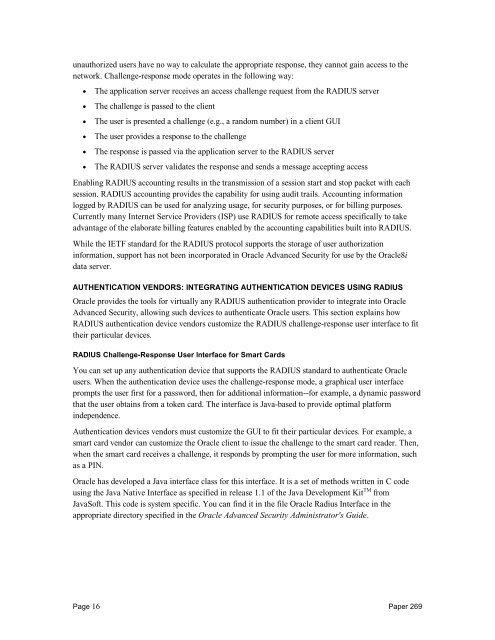Oracle 8i Security: New Features and Secure Solutions - CGISecurity
Oracle 8i Security: New Features and Secure Solutions - CGISecurity
Oracle 8i Security: New Features and Secure Solutions - CGISecurity
Create successful ePaper yourself
Turn your PDF publications into a flip-book with our unique Google optimized e-Paper software.
unauthorized users have no way to calculate the appropriate response, they cannot gain access to the<br />
network. Challenge-response mode operates in the following way:<br />
• The application server receives an access challenge request from the RADIUS server<br />
• The challenge is passed to the client<br />
• The user is presented a challenge (e.g., a r<strong>and</strong>om number) in a client GUI<br />
• The user provides a response to the challenge<br />
• The response is passed via the application server to the RADIUS server<br />
• The RADIUS server validates the response <strong>and</strong> sends a message accepting access<br />
Enabling RADIUS accounting results in the transmission of a session start <strong>and</strong> stop packet with each<br />
session. RADIUS accounting provides the capability for using audit trails. Accounting information<br />
logged by RADIUS can be used for analyzing usage, for security purposes, or for billing purposes.<br />
Currently many Internet Service Providers (ISP) use RADIUS for remote access specifically to take<br />
advantage of the elaborate billing features enabled by the accounting capabilities built into RADIUS.<br />
While the IETF st<strong>and</strong>ard for the RADIUS protocol supports the storage of user authorization<br />
information, support has not been incorporated in <strong>Oracle</strong> Advanced <strong>Security</strong> for use by the <strong>Oracle</strong><strong>8i</strong><br />
data server.<br />
AUTHENTICATION VENDORS: INTEGRATING AUTHENTICATION DEVICES USING RADIUS<br />
<strong>Oracle</strong> provides the tools for virtually any RADIUS authentication provider to integrate into <strong>Oracle</strong><br />
Advanced <strong>Security</strong>, allowing such devices to authenticate <strong>Oracle</strong> users. This section explains how<br />
RADIUS authentication device vendors customize the RADIUS challenge-response user interface to fit<br />
their particular devices.<br />
RADIUS Challenge-Response User Interface for Smart Cards<br />
You can set up any authentication device that supports the RADIUS st<strong>and</strong>ard to authenticate <strong>Oracle</strong><br />
users. When the authentication device uses the challenge-response mode, a graphical user interface<br />
prompts the user first for a password, then for additional information--for example, a dynamic password<br />
that the user obtains from a token card. The interface is Java-based to provide optimal platform<br />
independence.<br />
Authentication devices vendors must customize the GUI to fit their particular devices. For example, a<br />
smart card vendor can customize the <strong>Oracle</strong> client to issue the challenge to the smart card reader. Then,<br />
when the smart card receives a challenge, it responds by prompting the user for more information, such<br />
as a PIN.<br />
<strong>Oracle</strong> has developed a Java interface class for this interface. It is a set of methods written in C code<br />
using the Java Native Interface as specified in release 1.1 of the Java Development Kit TM from<br />
JavaSoft. This code is system specific. You can find it in the file <strong>Oracle</strong> Radius Interface in the<br />
appropriate directory specified in the <strong>Oracle</strong> Advanced <strong>Security</strong> Administrator's Guide.<br />
Page 16 Paper 269










